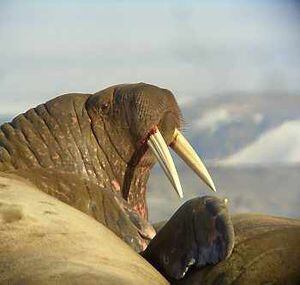The wild bunch
OF ALL the animals I wanted to see in the high Arctic, walrus topped the list.

OF ALL the animals I wanted to see in the high Arctic, walrus topped the list.
I had come close to seeing some in the Chukchi Sea, an area of the Arctic Ocean off eastern Siberia, on an expedition to find spoon-billed sandpipers in 1994.
Some of the party found a herd hauled ashore, but by the time we went back to see them the animals had gone. It was a great disappointment to me.
Why the fascination?
Some of the interest comes from The Beatles' Magical Mystery Tour, which featured a track called I Am The Walrus. The chorus went: 'I am the eggman, they are the eggmen. I am the walrus, goo goo g'joob.' The song is a classic, written by John Lennon, and included many Liverpool playground expressions around in the days when he was growing up.
But there is more to walruses than the drug-inspired lyrics of a 60s pop group.
They are extraordinary creatures, symbolic of the Arctic, stout-bodied and bewhiskered, with long white tusks and bulbous noses. At home on dazzlingly white pack ice or in the absolute darkness of the ocean seabed, they are revered by Inuits, who see in them human attributes.
Native Arctic people also cherish them as a major source of food and other materials on which they have depended for thousands of years.
They are huge creatures - males of the Atlantic race grow to 11ft long, while the Pacific walrus can be as large as 14ft.
Outwardly, they are similar in appearance to sea lions, except for their squarish heads and long tusks, which are found in both sexes.
Walruses stand and walk on all four limbs: the heels of the hind flippers are tucked under the rump to give support, while the palms of the forelimbs support the body with fingers turned backwards.
In water they propel themselves almost exclusively by means of the hind limbs, an adaptation for head-down bottom-feeding, using the forelimbs as rudders.
Walruses feed on shellfish dredged from silt, using their snouts as bulldozers and whiskers to locate the prey.
Their huge tusks, which can be up to 22 inches long, are not used in feeding. They are social tools, ice-crunchers and defensive weapons (we saw a polar bear with injuries that may have been inflicted by a walrus). They are also occasionally used as a fifth limb to help the huge creatures climb onto ice floes.
In any group of walruses, the dominant male always has by far the largest tusks.
My first encounter with walruses was on a small island off Spitsbergen, where a group of mainly males had hauled up to sunbathe. They had gone pink while sunbathing and were reminiscent of a herd of sleeping, contented pigs.
We had to approach them slowly and quietly in order not to spook them - animals are often injured when a sleeping herd is disturbed and bolts for the sea.
Walruses were not the only mammals present in the Svalbard archipelago.
Reindeer were plentiful on the islands, a smaller sub-species than those found in northern Norway, far to the south.
Both sexes have antlers, which were in 'velvet' at the time of my visit - that is, they were growing new ones that were still covered in a velvet-like skin. This skin dies and drops off, leaving a more familiar pair of white antlers once they have grown.
Dead reindeer are a windfall for polar bears and arctic foxes, neither of which could catch a healthy adult.
The foxes tend to hang around seabird colonies looking for sick and injured adults or, more likely, young birds that have fallen from their nests. We saw several at a kittiwake colony in a steep ravine where the living was clearly easy. A young kittiwake fluttered down from its nest high on a ledge, followed by its parents and other adult birds.
The youngster huddled in a corner and I commented to people around me that it was unlikely to survive.
My prediction came true faster than I anticipated and in a more dramatic fashion.
An Arctic fox spotted the fluttering bird across a valley at the base of the ravine, dashed down a scree-slope and across a stream and ascended the other side at a fantastic speed to grab the unfortunate kittiwake.
Happily (for the bird) it was dispatched swiftly and the fox started to run off with its prize. It did not get far, however, as another fox spotted the incident and chased the killer, taking the dead kittiwake and seeing off what must have been an intruder.
Our cruise around Spitsbergen included a trip down to the most southerly part of the continental shelf, where we spent an evening sea-watching primarily for whales.
It was not long before a group of spouts was seen - all about the same height, except one that was huge. The bulk were made, I am sure, by fin whales, but the huge spout could easily have been my first blue whale.
I will never know, as the ship continued on a southerly course without altering direction. Spotters on the bridge had seen a pod of white-beaked dolphins ahead and we were heading towards them.
White-beaked are one of the largest oceanic dolphins, with huge scimitar-shaped dorsal fins and grey markings on their backs and flanks. They are active animals - often leaping from the water - and put on a great show.
Nevertheless, I was sad not to have reached a conclusion about the huge spout.
More whales were soon spotted ahead, at first identified as humpbacks, but as we drew closer the spouts seemed to be veering off at an angle. Normally this would indicate sperm whales, which have only one nostril on the left side of the head. This results in a spout which is low and shoots off to the left.





